指纹图谱及高效液相
- 格式:ppt
- 大小:884.50 KB
- 文档页数:29
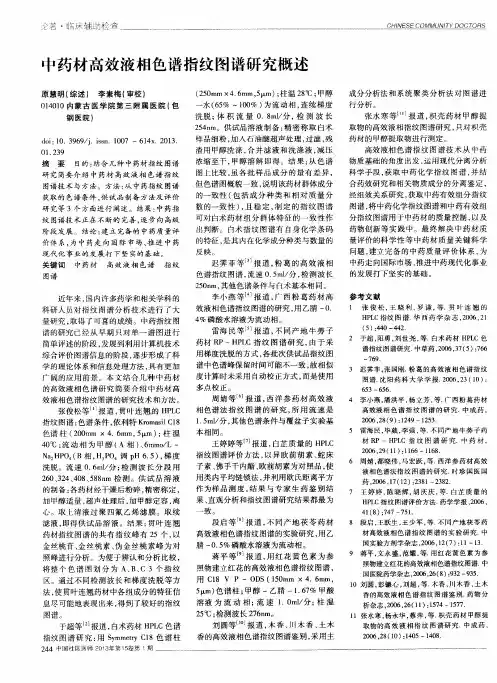
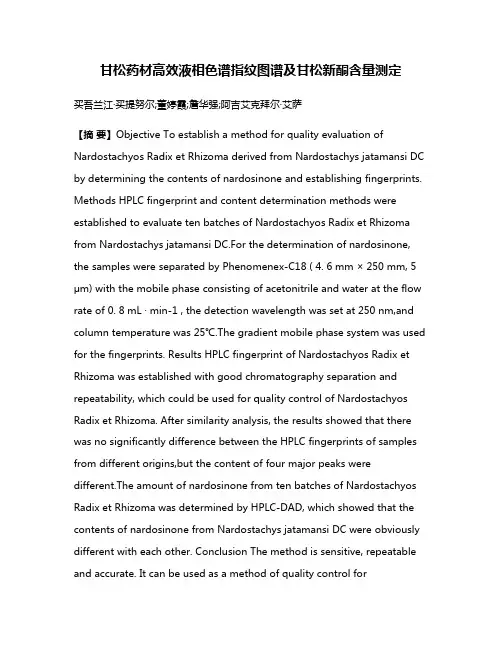
甘松药材高效液相色谱指纹图谱及甘松新酮含量测定买吾兰江·买提努尔;董婷霞;詹华强;阿吉艾克拜尔·艾萨【摘要】Objective To establish a method for quality evaluation of Nardostachyos Radix et Rhizoma derived from Nardostachys jatamansi DC by determining the contents of nardosinone and establishing fingerprints. Methods HPLC fingerprint and content determination methods were established to evaluate ten batches of Nardostachyos Radix et Rhizoma from Nardostachys jatamansi DC.For the determination of nardosinone, the samples were separated by Phenomenex-C18 ( 4. 6 mm × 250 mm, 5 μm) with the mobile phase consisting of acetonitrile and water at the flow rate of 0. 8 mL · min-1 , the detection wavelength was set at 250 nm,and column temperature was 25℃.The gradient mobile phase system was used for the fingerprints. Results HPLC fingerprint of Nardostachyos Radix et Rhizoma was established with good chromatography separation and repeatability, which could be used for quality control of Nardostachyos Radix et Rhizoma. After similarity analysis, the results showed that there was no significantly difference between the HPLC fingerprints of samples from different origins,but the content of four major peaks were different.The amount of nardosinone from ten batches of Nardostachyos Radix et Rhizoma was determined by HPLC-DAD, which showed that the contents of nardosinone from Nardostachys jatamansi DC were obviously different with each other. Conclusion The method is sensitive, repeatable and accurate. It can be used as a method of quality control forNardostachyos Radix et Rhizoma.%目的研究甘松药材的高效液相色谱(HPLC)指纹图谱,测定甘松新酮含量,以建立药材有效的质量评价方法 .方法通过建立HPLC 指纹图谱和有效成分含量测定方法,对10批甘松药材进行分析.HPLC色谱条件:色谱柱为Phenomenex-C18(4.6 mm×250 mm,5μm);流动相:乙腈-水(60:40);流速:0.8 mL·min-1;检测波长:250 nm;柱温:25℃.指纹图谱流动相为梯度洗脱.结果得到分离度、重复性很好的甘松药材HPLC指纹图谱,对10批不同甘松药材的色谱指纹图谱进行相似度评价,不同产地甘松药材指纹图谱差异不大,但4个代表性峰含量有所区别.HPLC-DAD法测定10批甘松样品中甘松新酮的含量,结果显示不同产地甘松药材中甘松新酮含量差异较大.结论该方法简便、准确、重复性好,可作为甘松药材的质量控制方法.【期刊名称】《医药导报》【年(卷),期】2017(036)011【总页数】5页(P1298-1302)【关键词】甘松;甘松新酮;色谱法,高效液相;质量控制;指纹图谱【作者】买吾兰江·买提努尔;董婷霞;詹华强;阿吉艾克拜尔·艾萨【作者单位】中国科学院新疆理化技术研究所新疆特有药用资源利用重点实验室,乌鲁木齐 830011;香港科技大学生命科学部暨中药研发中心,香港;香港科技大学生命科学部暨中药研发中心,香港;中国科学院新疆理化技术研究所新疆特有药用资源利用重点实验室,乌鲁木齐 830011【正文语种】中文【中图分类】R286;R927.1甘松为败酱科植物甘松(Nardostachys jatamansi DC.)的干燥根及根茎。
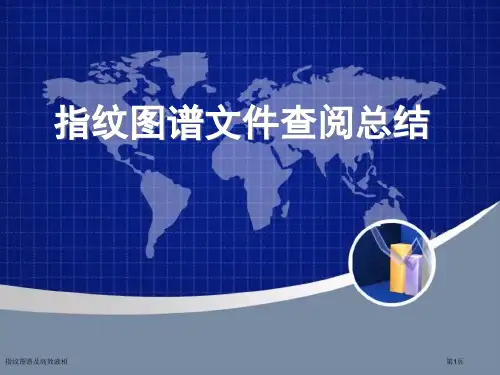
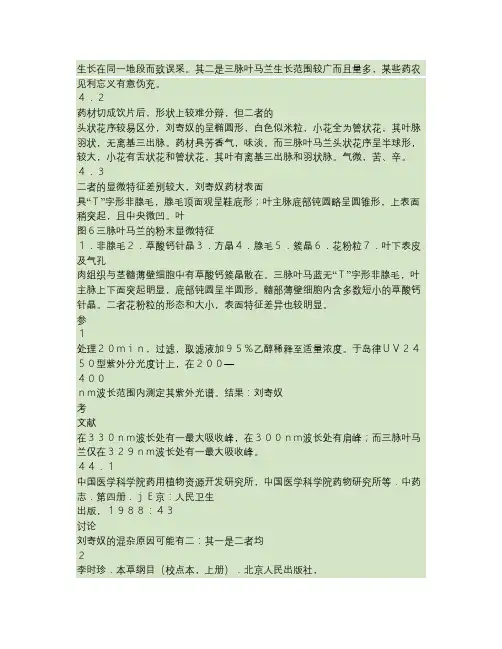
生长在同一地段而致误采。
其二是三脉叶马兰生长范围较广而且量多,某些药农见利忘义有意伪充。
4.2药材切成饮片后,形状上较难分辩,但二者的头状花序较易区分,刘寄奴的呈椭圆形,白色似米粒,小花全为管状花,其叶脉羽状,无离基三出脉。
药材具芳香气,味淡。
而三脉叶马兰头状花序呈半球形,较大,小花有舌状花和管状花,其叶有离基三出脉和羽状脉。
气微,苦、辛。
4.3二者的显微特征差别较大,刘寄奴药材表面具“T”字形非腺毛,腺毛顶面观呈鞋底形;叶主脉底部钝圆略呈圆锥形,上表面稍突起,且中央微凹。
叶图6三脉叶马兰的粉末显微特征1.非腺毛2.草酸钙针晶3.方晶4.腺毛5.簇晶6.花粉粒7.叶下表皮及气孔肉组织与茎髓薄壁细胞中有草酸钙簇晶散在。
三脉叶马蓝无“T”字形非腺毛,叶主脉上下面突起明显,底部钝圆呈半圆形。
髓部薄壁细胞内含多数短小的草酸钙针晶。
二者花粉粒的形态和大小,表面特征差异也较明显。
参1处理20min,过滤,取滤液加95%乙醇稀释至适量浓度。
于岛律UV2450型紫外分光度计上,在200—400nm波长范围内测定其紫外光谱。
结果:刘寄奴考文献在330nm波长处有一最大吸收峰,在300nm波长处有肩峰;而三脉叶马兰仅在329nm波长处有一最大吸收峰。
44.1中国医学科学院药用植物资源开发研究所,中国医学科学院药物研究所等.中药志.第四册.jE京:人民卫生出版,1988:43讨论刘寄奴的混杂原因可能有二:其一是二者均2李时珍.本草纲目(校点本,上册).北京人民出版社,199l:959来源于菊科植物,在开花之前茎叶的形状和色泽均有相似之处,其生长环境与习性相似,且二者常混杂(2003一11—26收稿)紫菀药材的高效液相色谱指纹图谱与定量分析周军辉1伍蔚萍1谢子民2孙文基h(1.西北大学陕西省生物医药重点实验室,西安710069;2.西安市药品检验所,西安710068)摘要目的:建立紫菀药材的反相液相色谱定性和定量鉴别分析方法。
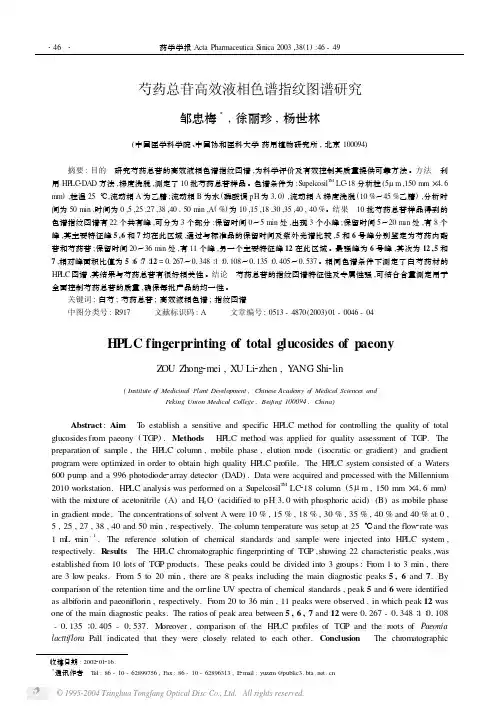
芍药总苷高效液相色谱指纹图谱研究邹忠梅3,徐丽珍,杨世林(中国医学科学院、中国协和医科大学药用植物研究所,北京100094)摘要:目的 研究芍药总苷的高效液相色谱指纹图谱,为科学评价及有效控制其质量提供可靠方法。
方法 利用HP LC2DAD方法,梯度洗脱,测定了10批芍药总苷样品。
色谱条件为:Supelcosil T M LC218分析柱(5μm,150mm×416 mm),柱温25℃,流动相A为乙腈;流动相B为水(磷酸调pH为310),流动相A梯度洗脱(10%~45%乙腈),分析时间为50min,时间为0,5,25,27,38,40,50min,A(%)为10,15,18,30,35,40,40%。
结果 10批芍药总苷样品得到的色谱指纹图谱有22个共有峰,可分为3个部分:保留时间0~5min处,出现3个小峰;保留时间5~20min处,有8个峰,其主要特征峰5,6和7均在此区域,通过与标准品的保留时间及紫外光谱比较,5和6号峰分别鉴定为芍药内酯苷和芍药苷;保留时间20~36min处,有11个峰,另一个主要特征峰12在此区域。
最强峰为6号峰,其次为12,5和7,相对峰面积比值为5∶6∶7∶12=01267~01348∶1∶01108~01135∶01405~01537。
相同色谱条件下测定了白芍药材的HP LC图谱,其结果与芍药总苷有很好相关性。
结论 芍药总苷的指纹图谱特征性及专属性强,可结合含量测定用于全面控制芍药总苷的质量,确保每批产品的均一性。
关键词:白芍;芍药总苷;高效液相色谱;指纹图谱中图分类号:R917 文献标识码:A 文章编号:0513-4870(2003)01-0046-04HPLC fingerprinting of total glucosides of paeonyZ OU Zhong2mei,X U Li2zhen,Y ANG Shi2lin(Institute o f Medicinal Plant Development,Chinese Academy o f Medical Sciences andPeking Union Medical College,Beijing100094,China)Abstract:Aim T o establish a sensitive and specific HP LC method for controlling the quality of total glucosides from paeony(TG P).Methods HP LC method was applied for quality assessment of TG P.The preparation of sam ple,the HP LC column,m obile phase,elution m ode(is ocratic or gradient)and gradient program were optimized in order to obtain high quality HP LC profile.The HP LC system consisted of a Waters 600pum p and a996photodiode2array detector(DAD).Data were acquired and processed with the Millennium 2010w orkstation.HP LC analysis was performed on a Supelcosil T M LC218column(5μm,150mm×416mm) with the mixture of acetonitrile(A)and H2O(acidified to pH310with phosphoric acid)(B)as m obile phase in gradient m ode.The concentrations of s olvent A were10%,15%,18%,30%,35%,40%and40%at0, 5,25,27,38,40and50min,respectively.The column tem perature was setup at25℃and the flow2rate was 1m L·min-1.The reference s olution of chemical standards and sam ple were injected into HP LC system, respectively.R esults The HP LC chromatographic fingerprinting of TG P,showing22characteristic peaks,was established from10lots of TG P products.These peaks could be divided into3groups:From1to3min,there are3low peaks.From5to20min,there are8peaks including the main diagnostic peaks5,6and7.By com paris on of the retention time and the on2line UV spectra of chemical standards,peak5and6were identified as albiforin and paeoniflorin,respectively.From20to36min,11peaks were observed,in which peak12was one of the main diagnostic peaks.The ratios of peak area between5,6,7and12were01267-01348∶1∶01108 -01135∶01405-01537.M oreover,com paris on of the HP LC profiles of TG P and the roots of Paeonia lacttiflora Pall indicated that they were closely related to each other.Conclusion The chromatographic收稿日期:2002201216.3通讯作者 T el:86-10-62899756,Fax:86-10-62896313,E2mail:yuzzm@fingerprinting of TG P with high specificity can be used to control its quality and assure lot to lot consistency.K ey w ords:Paeonia lacttiflora;total glucosides of paeony;HP LC;fingerprinting 白芍为毛茛科植物芍药Paeonia lacttiflora Pall.的干燥根。
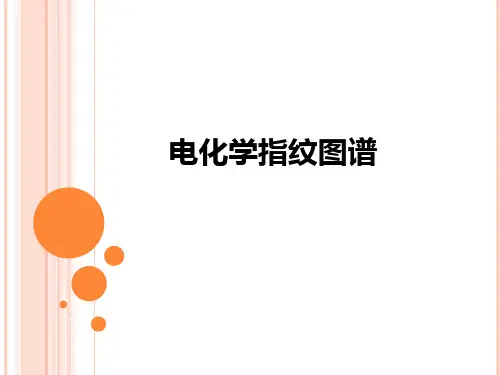
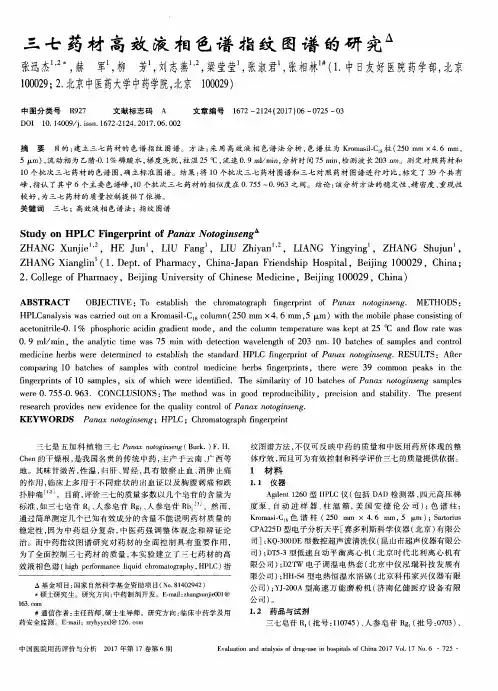
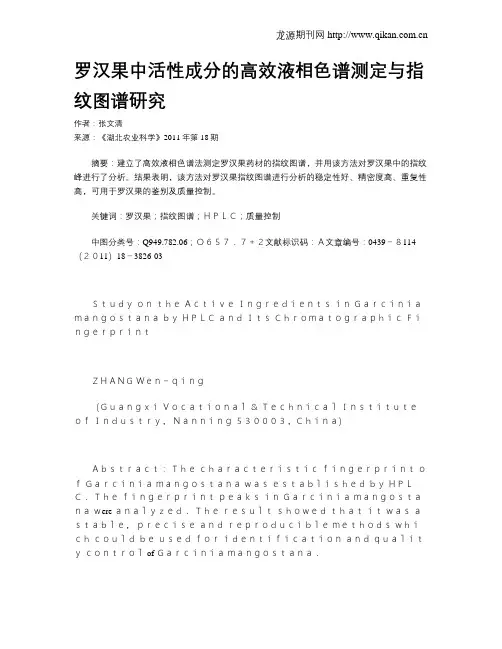
罗汉果中活性成分的高效液相色谱测定与指纹图谱研究作者:张文清来源:《湖北农业科学》2011年第18期摘要:建立了高效液相色谱法测定罗汉果药材的指纹图谱,并用该方法对罗汉果中的指纹峰进行了分析。
结果表明,该方法对罗汉果指纹图谱进行分析的稳定性好、精密度高、重复性高,可用于罗汉果的鉴别及质量控制。
关键词:罗汉果;指纹图谱;HPLC;质量控制中图分类号:Q949.782.06;O657.7+2文献标识码:A文章编号:0439-8114(2011)18-3826-03StudyontheActiveIngredientsinGarciniamangostanabyHPLCandItsChromatographicFingerprintZHANGWen-qing(GuangxiVocational&TechnicalInstituteofIndustry,Nanning530003,China)Abstract:ThecharacteristicfingerprintofGarciniamangostanawasestablishedbyHPLC.ThefingerprintpeaksinGarciniamangostanawere analyzed.Theresultshowedthatitwasastable,preciseandreproduciblemethodswhichcouldbeusedforidentificationandqualitycontrol of Garciniamangostana.Keywords:Garciniamangostana;fingerprint;HPLC;qualitycontrol中药罗汉果(Siraitiagrosvenorii)是葫芦科罗汉果属植物[Siraitiagrosvenorii(Swingle)C.Jeffery]的成熟果实。
性凉味甘,具有清热解渴,润肺止咳之效,可用于治疗喉痛、慢性咽喉炎、咽喉失音、慢性支气管炎、哮喘、百日咳、高血压、便秘病症等[1]。
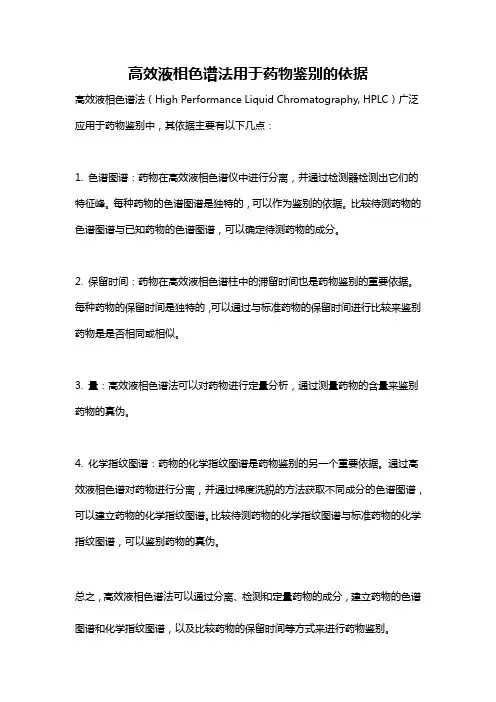
高效液相色谱法用于药物鉴别的依据
高效液相色谱法(High Performance Liquid Chromatography, HPLC)广泛应用于药物鉴别中,其依据主要有以下几点:
1. 色谱图谱:药物在高效液相色谱仪中进行分离,并通过检测器检测出它们的特征峰。
每种药物的色谱图谱是独特的,可以作为鉴别的依据。
比较待测药物的色谱图谱与已知药物的色谱图谱,可以确定待测药物的成分。
2. 保留时间:药物在高效液相色谱柱中的滞留时间也是药物鉴别的重要依据。
每种药物的保留时间是独特的,可以通过与标准药物的保留时间进行比较来鉴别药物是是否相同或相似。
3. 量:高效液相色谱法可以对药物进行定量分析,通过测量药物的含量来鉴别药物的真伪。
4. 化学指纹图谱:药物的化学指纹图谱是药物鉴别的另一个重要依据。
通过高效液相色谱对药物进行分离,并通过梯度洗脱的方法获取不同成分的色谱图谱,可以建立药物的化学指纹图谱。
比较待测药物的化学指纹图谱与标准药物的化学指纹图谱,可以鉴别药物的真伪。
总之,高效液相色谱法可以通过分离、检测和定量药物的成分,建立药物的色谱图谱和化学指纹图谱,以及比较药物的保留时间等方式来进行药物鉴别。
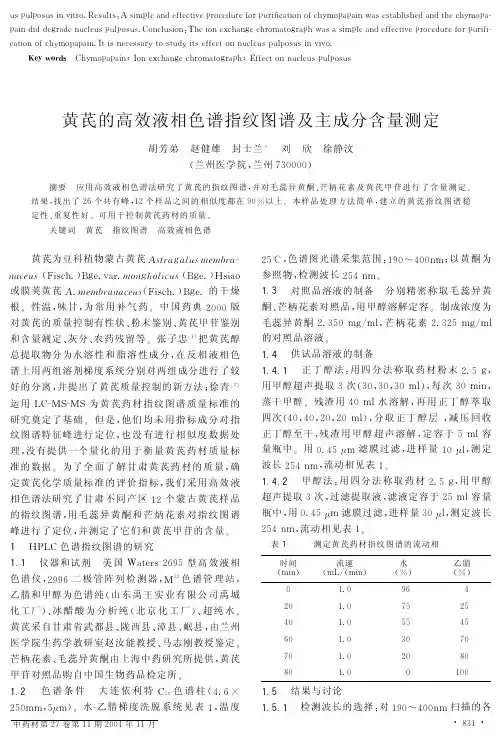
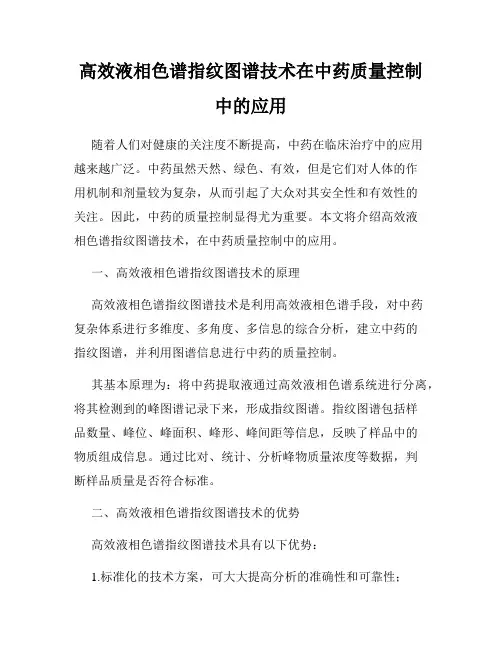
高效液相色谱指纹图谱技术在中药质量控制中的应用随着人们对健康的关注度不断提高,中药在临床治疗中的应用越来越广泛。
中药虽然天然、绿色、有效,但是它们对人体的作用机制和剂量较为复杂,从而引起了大众对其安全性和有效性的关注。
因此,中药的质量控制显得尤为重要。
本文将介绍高效液相色谱指纹图谱技术,在中药质量控制中的应用。
一、高效液相色谱指纹图谱技术的原理高效液相色谱指纹图谱技术是利用高效液相色谱手段,对中药复杂体系进行多维度、多角度、多信息的综合分析,建立中药的指纹图谱,并利用图谱信息进行中药的质量控制。
其基本原理为:将中药提取液通过高效液相色谱系统进行分离,将其检测到的峰图谱记录下来,形成指纹图谱。
指纹图谱包括样品数量、峰位、峰面积、峰形、峰间距等信息,反映了样品中的物质组成信息。
通过比对、统计、分析峰物质量浓度等数据,判断样品质量是否符合标准。
二、高效液相色谱指纹图谱技术的优势高效液相色谱指纹图谱技术具有以下优势:1.标准化的技术方案,可大大提高分析的准确性和可靠性;2.对中药体系中的芳香族、酚、生物碱等具有不同极性和不同分子量的化合物都能进行检测,适用范围广;3.检测结果直观,比较客观,可以较准确地反映药材本质和组成;4.可以通过比对已建立的公开指纹图谱库对中药的质量进行定量和定性分析,提高了分析效率和准确性;5.技术操作相对简单,峰型分离准确,重现性好。
三、高效液相色谱指纹图谱技术在中药质量控制中的应用目前,高效液相色谱指纹图谱技术在中药质量控制中的应用已经得到了广泛的认可。
其应用领域主要包括以下几个方面:1.辨识防伪性在中药的种类繁多的情况下,对于一些常见草药、药材,可以采用指纹图谱技术,对比分析检测样品和已知指纹图谱,如果完全一致,说明质量上乘,如果出现差异,可能意味着品质欠佳甚至是假药。
2.质量评价与控制中药材质量的差异通常来自于其生长环境、采收季节、保管期限等因素,因此,需要建立相应的质量指标和标准,科学地评价和控制中药质量。
・3420・WORLD CHILESE MEDICILE Octoneg.2420,Voi.15,No.20四逆汤高效液相指纹图谱的建立及含量测定阮癑林燕张晓燕余世荣石金敏(湖北省十堰市人民医院/湖北医药学院附属人民医院药学部,十堰,44250)摘要目的:通过高效液相色谱法(HPLC)对四逆汤进行指纹图谱的建立。
方法:对HPLC法进行常规的可靠性方法学考察,包括专属性、精密度、稳定性等,然后进一步采用HPLC对四逆汤进行指纹图谱的建立,在此基础上比较14批不同四逆汤样品的相似度,并进行含量测定。
结果:1)线性回归考察中结果显示在一定的线性范围內四逆汤中的次乌头碱对照品、9-姜酚对照品、和甘草苷对照品溶液线性关系考察均显示良好。
2)乌头碱、9-姜酚和甘草苷在精密度试验、稳定性试验和重复性试验中RSD值分别为4.47%、0.96%、0.39%,2.11%、2.D%.!!,%,1.53%、1.97%、1.42%,均显示四逆汤在HPLC检测中的精密度、稳定性和重复性均较好。
3)四逆汤中次乌头碱、9-姜酚和甘草苷的含量测定中15个不同批次的四逆汤在3个成分中差异均无统计学意义(P<4.45),其平均测得量为(15.99±4.5)Ma/mL、(6291±4.79)丛^1^、(349.79±4.26)(jca/mL。
结论:采用高效液相对四逆汤进行指纹图谱的建立和相似度比较分析及含量测定发现,四逆汤的质量稳定性均一,可作为临床疗效的稳定性提供药理学实验依据。
关键词高效液相色谱法;四逆汤;指纹图谱;次乌头碱4-姜酚;甘草苷;含量测定;药理实验EstabUshmeut of High Performance LiquiV Chramatographic Fingerarini of Sini Decoctionand Its Conteni DeterminationRUAN Yue,LIN Yan,ZHANG Xinyn,YU Shirouf,SH)Jinmin(Shiyan People's Hospital/Pharmach DeparOnent‘Peopled Hospital Affiliated ia Hubai Medical Cofege,Shiyan442004,China) Abstract Objective:To establish t he finaerprint of Sini Decoctioo by high performance liquiC chromatoarayhy(HPLC).Methods:The rontine reoabioty methonolohy of HPLC methoP was invespaateP,incluUina specificity,precision and stayility etc.,and HPLC was useP for the estayoshmept of finaerprint of Sini Decoctioo.On this basis,the similarity of15batches of diOerect Sini De-coctioo samples were compareP,and the cootept was determineP.Respite:1)The results of onear repressioo investiaatiop showeP within a certain Unear ranae,the Unear relatioPsPic of the subacopitine referecco substance,6-sinaerol referecco substance,and glys cyrrUizin referecco suUstance solutioo in Sini Decoctioo showeP aooP results.2)The RSD values of acooiOne,6-3inaerol and glycyos rhizin in precisioo test,sWbiUty test and upewbioty test were4.47%, 4.86%,4.39%,2.11%,2.63%,1.75%,1.53%, 1.97%and1.40%,respectively,which showeP that Sini Decoctioo hab aooP precisioo,stability and repeatability in HPLC detec-tioo.3))n the determinatioo of the cootects of sub-scooiOne,9-3inaeroi and glycyrrhizin in Sini Decoctioo,there was no sianificant diOerecce amooc the3compopects io15diOerect batches of Sini Decoction,and the averaye coptects were(15.86±4.)ua/mL, (60.21tOUjua/mL and(309.96±4. 26)u//m L.Conclusion:HPLC relative to Sini Decoctioo was useP fcu the estaboshmect of finaerprints,similarity compaUsoo analysis and cootent determinatioo fonud that that Sini Decoctioo hab uuiform quality and sta-biUty,which conlU proviCe pharmacolopical expeUoectal basis for the stability of clinical efficach.Keywonit High peUormance liquiC chromatoprayhy;Sini Decoctioo;FOaerpUnt;HypacooiOne;6-3inaercl-Glycyrrhizin;Coo-Wct determinatioo;Pharmacolopicai expeUoect中图分类号:R224.1文献标识码:A dot:14.3969/j.isn.1673-7242.2024.24.345《伤寒论》中收录了四逆汤,而这一仅由附子、炙甘草和干姜3味药材组成的药方,是以回阳与救逆并重的重要代表方,这个方的药物组成虽然简单,但是药效极其复杂,是中药中七情配伍的典型代表方药。
吴茱萸高效液相色谱指纹图谱的研究引言吴茱萸是一种常用的中药材,具有一定的药理作用。
在对吴茱萸进行研究时,常常使用高效液相色谱技术。
高效液相色谱指纹图谱是指以高效液相色谱技术为手段,对吴茱萸进行建立指纹图谱的研究。
本文将介绍吴茱萸高效液相色谱指纹图谱的研究进展。
吴茱萸研究历史吴茱萸是一种历史悠久的中药材,早在《本草纲目》中就有记载。
随着中药材研究的深入,人们对吴茱萸的认识也不断加深。
在近年来,随着高效液相色谱技术的发展,吴茱萸的研究也进一步深入。
高效液相色谱介绍高效液相色谱,简称HPLC,是一种分离和检测化合物的方法。
与其他分离方法相比,HPLC具有分离效率高、分离速度快、操作简便、分析精度高等优点。
使用HPLC建立指纹图谱是中药质量控制的一个重要方法。
吴茱萸高效液相色谱指纹图谱研究进展1.吴茱萸指纹图谱建立方法建立吴茱萸指纹图谱需要先对样品进行处理和提取。
常用的处理方法有提取、溶解和加热等。
提取方法主要有超声波提取法、微波提取法和气相色谱法等。
建立指纹图谱的HPLC系统通常由流动相和固定相两部分组成,固定相常常是C18等反相固定相。
对各种参数进行优化,选取最佳的分离条件,使用荧光检测器、紫外检测器等对各个峰进行检测,最后使用数学处理方法对得到的数据进行处理。
2.吴茱萸指纹图谱的应用吴茱萸指纹图谱可以用于对吴茱萸的药效成分进行研究和分析,也可以用于吴茱萸的质量控制。
通过对指纹图谱的比较和分析,可以快速、准确地鉴定吴茱萸中的化合物,为吴茱萸的药理研究提供有力的支持。
结论吴茱萸高效液相色谱指纹图谱是中药研究的重要手段之一,其对吴茱萸药效成分的分析和鉴定具有重要意义。
通过对各种参数的优化和合理的数据处理方法,可以建立准确可靠的吴茱萸指纹图谱,为中药质量控制提供有力的保障。
国家局关于指纹图谱的定义(精)国家药品监督管理局二○○○年八月十五日为了加强中药注射剂的质量管理,确保中药注射剂的质量稳定、可控,中药注射剂在固定中药材品种、产地和采收期的前提下,需制定中药材、有效部位或中间体、注射剂的指纹图谱。
一、注射剂用中药材指纹图谱研究的技术要求中药材指纹图谱系指中药材经适当处理后,采用一定的分析手段,得到的能够标示该中药材特性的共有峰的图谱。
如原药材需经过特殊炮制(如醋制、酒制、炒炭等),则应制定原药材和炮制品指纹图谱的检测标准。
(一)指纹图谱的检测标准包括名称、汉语拼音、拉丁名、来源、供试品和参照物的制备、检测方法、指纹图谱及技术参数。
有关项目的技术要求如下:1.名称、汉语拼音按中药命名原则制定。
2.来源包括原植、动物的科名、中文名、拉丁学名、药用部位、产地、采收季节、产地加工、炮制方法等,矿物药包括矿物的类、族、矿石名或岩石名、主要成分、产地、产地加工、炮制方法等。
动、植物药材均应固定品种、药用部位、产地、采收期、产地加工和炮制方法,矿物药应固定产地和炮制、加工方法。
供试品的取样参照《中国药典》2000年版中规定的中药材的取样方法,以保证供试品的代表性和均一性。
3.供试品的制备应根据中药材中所含化学成分的理化性质和检测方法的需要,选择适宜的方法进行制备。
制备方法必须确保该中药材的主要化学成分在指纹图谱中的体现。
对于仅提取其中某类或数类成分的中药材,除按化学成分的性质提取各类成分制定指纹图谱外,还需按注射剂制备工艺制备供试品,制定指纹图谱,用以分析中药材与注射剂指纹图谱的相关性。
4.参照物的制备制定指纹图谱必须设立参照物,应根据供试品中所含成分的性质,选择适宜的对照品作为参照物,如果没有适宜的对照品,可选择适宜的内标物作为参照物。
参照物的制备应根据检测方法的需要,选择适宜的方法进行。
5.测定方法包括测定方法、仪器、试剂、测定条件等。
应根据中药材所含化学成分的理化性质,选择适宜的测定方法。
1. 1 色谱指纹图谱:
色谱指纹图谱包括TLCS、HPLC、GC、HSCCC和HPCE,主要应用的指纹图谱是GC和HPLC。
另外, HPCE指纹图谱研究也有着广泛的应用前景。
1.1.1高效液相色谱(HPLC)指纹图谱:具有适用范围广、选择性强、分离性能好、分析速度快、灵敏度高、样品用量少等优点,是一种评价天然药物真实性、稳定性和一致性的有效质量控制方法。
周玉新等[4]应用HPLC一DAD对三七药材、提取物及其注射液的皂昔类成分进行指纹图谱研究,获得三七药材、提取物及其注射液的具有专属性的三维指纹图谱。
翟为民等[5]应用HPLC一DAD对人参、西洋参和三七参进行了指纹图谱研究,采用梯度洗脱分离分析了其皂苷成分,可以有效的鉴别人参、西洋参和三七参。
1.1.2气相色谱(GC)指纹图谱:多用于天然药物中挥发性成分的测定,也有经衍生化反应后用于分析天然药物的其他成分如生物碱类、脂肪类、内脂类、酚类、糖类药物等。
梁倩等[6]建立了金银花药材挥发油的GC指纹图谱,并采用水蒸气蒸馏法提取、GC法分析对比了10批金银花药材挥发油的成分,结果表明, 10批金银花药材的挥发油相似度较高,该法可作为金银花药材的质量控制方法。
1.1.3高效毛细管电泳(HPCE):季一兵[7] 等用50µm *50cm 未涂渍的毛细管柱, 20mmol/L硼砂溶液作缓冲液,运行电压为15kV,检测波长210nm, 建立了丹参中药材的HPCE 指纹图谱。
1.1.4、高速逆流色谱(HSCCC):顾铭等[8]采用HSCCC法, 以正己烷- 乙醇- 水体系采用分步洗脱, 建立了丹参药材中脂溶性成分的HSCCC 指纹图谱;。
关于红花药材高效液相色谱指纹图谱初步研究的综述摘要目的:利用高效液相色谱建立新疆地区红花的色谱指纹图谱。
方法:采用反相C18柱,乙腈一0.5%磷酸水溶液梯度洗脱;检测波长275 rim;流速1.0mIJmin进行试验。
结果:从7个地区出产的红花获得色谱共有峰,比较基本特征。
羟基红花黄色素A为指标成分,看哪个红花的含量为最高。
结论:该法为中药样品的鉴定提供了较全面的信息,红花样品指纹图谱及指标成分含量测定可用于全面控制红花药材的质量。
关键词红花;高效液相;指纹图谱前言:红花为菊科植物红花Carthamus tinctorius L. 的干燥花,具有活血通经、散瘀止痛的功效,是传统的活血化瘀中药现代药理研究表明红花对心血管系统有广泛而显著的作用,临床疗效确切,大量用于中成药生产和临床处方。
因此,建立红花药材有效的质量评价方法,对不同产地红花药材的质量进行系统的比较研究,确保红花药材质量稳定,直接关系到红花相关药品和临床处方的疗效。
谱指纹图谱用于中药的表征和质量控制已越来越引起广泛的关注。
色谱指纹图谱是在固定实验条件和实验方法,得到同一样品不同批次色谱图谱。
美国FDA最近几年制定的植物草药指南已把指纹图谱作为这类混合物质群的质量控制方法。
欧洲也将色谱指纹图谱作为植物药制剂的评价方法。
本文采用高效液相色谱法,建立红花药材的指纹图谱,对不同来源的红花药材进行比较研究,为红花的质量控制提供有效方法。
正文:1材料与仪器1.1仪器与试药Agilent一1100高效液相色谱仪;四元泵,DAD检测器;G137PA自动脱气机;标准自动进样器;柱温色谱柱Zorhax SB—C18柱(4.6mln×250 mln,5 tnn)。
乙腈为色谱纯(Fisher);水为二次蒸馏水;羟基红花黄色素A对照品(中国药品生物制品检定所,批号:0782—200310);红花药材由武汉大学药学院张洪教鉴定为菊科植物红花能心地矾淞tinctorius L.的干燥花(符合中国药典2000年版一部)。